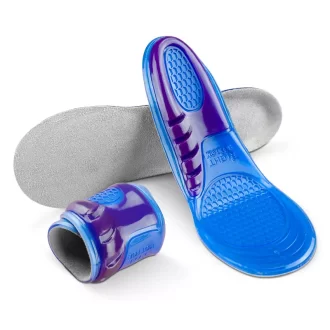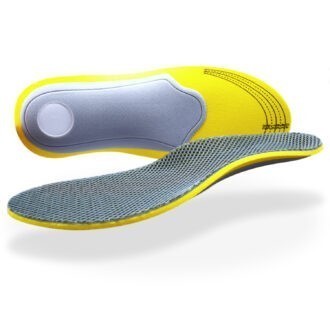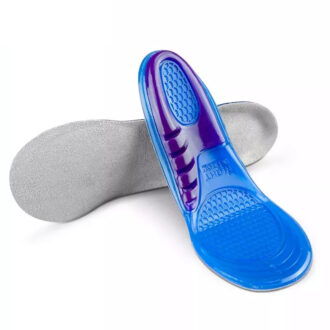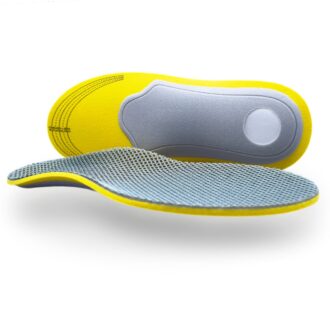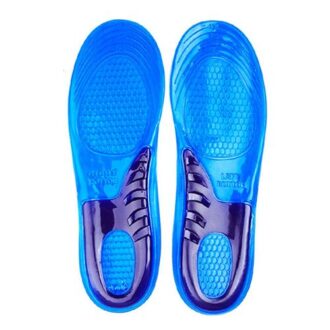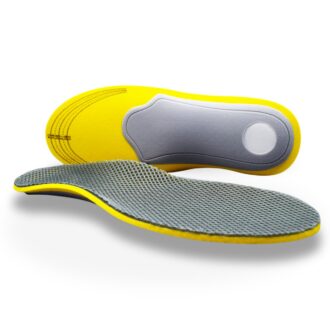No products in the cart.
Insoles for Heel pain
Discover Relief from Heel Pain with NuovaHealth Insoles
Are you one of the countless individuals suffering from persistent heel pain? Imagine waking up each morning, already dreading the first step out of bed. Heel pain can cast a shadow over your daily life, turning simple activities like walking, standing, or even enjoying a leisurely stroll into agonizing ordeals. The culprit might be as simple as lacking proper support in your footwear.
Here at NuovaHealth, we understand the debilitating impact heel pain can have on your quality of life. That’s why we offer a diverse range of insoles designed to provide the relief and support you need. Our collection includes our very own NuovaHealth insoles as well as top-rated products from leading brands like Footrevivier. Each insole is crafted to address the specific needs of those suffering from heel discomfort, ensuring you find the perfect fit for your lifestyle and pain relief requirements.
Before we discuss why our insoles are the best choice for those suffering from heel pain, let’s explore some common causes of this discomfort and how the right insoles can make a significant difference.
At NuovaHealth, we’re committed to your well-being. Our insoles are more than just a product—they’re a step towards a pain-free life. Stay with us as we take a closer look at how our insoles can be the game-changer you’ve been searching for in your battle against heel pain.
Common Causes of Heel Pain and How Insoles Can Help
Heel pain can stem from a variety of conditions, each requiring a unique approach for effective relief and prevention. Below, you’ll find a comprehensive list of different injuries and conditions that can cause heel pain and how insoles can play a crucial role in treating and preventing these issues:
Why Choose NuovaHealth Insoles?
After identifying the cause of your heel pain, the next step is finding the right solution. NuovaHealth insoles are engineered to target the root causes of heel discomfort, offering tailored support and cushioning where you need it most. Here’s why our insoles stand out:
- Ergonomic Design: Our insoles are designed to conform to the natural curvature of your feet, ensuring an optimal fit and maximum comfort.
- Superior Materials: We use high-quality materials that provide excellent shock absorption and durability, reducing the impact on your heels with every step.
- A Wide Range of Options: With a variety of insoles available, including options for different arch types and activity levels, you can find the perfect insole to match your specific needs.
- Proven Effectiveness: Our insoles are backed by positive feedback from countless users who have experienced significant relief from heel pain.
Easy Steps to a Pain-Free Life
- Identify Your Condition: Use the list above to determine the potential cause of your heel pain.
- Select the Right Insole: Choose from our range of insoles tailored to address your specific condition and lifestyle requirements.
- Experience Relief: Feel the difference as our insoles provide the support and cushioning needed to alleviate pain and enhance your daily activities.
Don’t let heel pain control your life. With NuovaHealth insoles, you can take a confident step towards relief and regain your active lifestyle. Explore our collection today and find the perfect insole to help you live pain-free.
Disclaimer:
At NuovaHealth, your well-being is our top priority.
Please note that heel pain can result from a variety of conditions, including plantar fasciitis, Achilles tendonitis, and heel spurs, among others. Insoles offer support, cushioning, and alignment, which can help alleviate pain and improve your overall foot health. However, it’s crucial to consult with a doctor or podiatrist to get a proper diagnosis and treatment plan tailored to your specific needs.
Why is this important? A healthcare professional can identify the underlying cause of your heel pain and suggest the most effective treatments. They can recommend whether wearing insoles from our range is right for you, or if other interventions are necessary for your condition. This personalized approach ensures that you receive the right care, which can lead to faster recovery and better long-term outcomes.
At NuovaHealth, we are committed to providing products that genuinely work for you. By seeking medical advice, you can make informed decisions about your health and maximize the benefits of our insoles. Remember, taking the time to get a proper diagnosis is a crucial step in your journey to a pain-free life.
Your health and comfort matter to us. Explore our range of insoles with confidence, knowing that professional guidance is just as important as the quality of the products you choose.
Gel Footbed Insoles for trainers
- 1x Pair of Gel Footbed Insoles for trainers and running shoes to help protect your feet and lower limbs from shock when running, exercising or playing sports
- For both Men & Women
- Available in sizes 6-9 & 8-12 (trim to fit)
- Recommended for people suffering from Plantar fasciitis, Heel Spurs, Flat feet, High arches, Achilles tendonitis, Arthritis, Neuropathy, Diabetes, Raynaud’s disease, Poor circulation, Metatarsalgia, Morton’s neuroma, Bunions, Pes Cavus, Sesamoiditis, Cuboid Syndrome, Ankle sprains, Shin splints as well as Knee, Hip and lower back pain
- Made from medical grade silicone gel that massages your feet and helps prevent foot fatigue and improves muscle recovery by stimulating the blood vessels in your feet to boost the circulation in them
- Helps cushion your feet and absorbs shock and vibrations whenever your feet strike the ground when walking, running and jumping to deplete the impact felt on key ligaments, tendons and joints found in your feet, knees, hips and lower back
- The silicone gel moulds to the exact shape and contours of your feet to provide a custom level of support and protection
- Helps correct common gait problems and biomechanical imbalances known to cause injury such as Overpronation and supination
- Provides supports your arches in the correct position and helps take strain and pressure off your plantar fascia ligament to help prevent and treat Plantar fasciitis
- 3/4 length heel cup provides extra support and stability to your heels and ankles and prevents heel pain by spreading weight evenly underneath your heels to stop pressure points from developing when stood for long period of time
- Lightweight and breathable design featuring moisture wicking technology and antibacterial properties to keep your feet fresh and odour free
- Includes a full 30-day money back guarantee!
£11.99inc VATFootbed Insoles for Fallen Arches (Flat feet)
- 1x Pair of Footbed Insoles for Fallen Arches (Flat feet) designed to support, ease and treat foot injuries such as Plantar fasciitis
- For both Men & Women
- Available in sizes: 7-11 & 3-7
- Provides substantial arch support to help take strain and pressure off your plantar fascia ligament allowing you to recover properly from injuries such as Plantar fasciitis
- Ideal for people with flat feet, high arches, diabetes, Neuropathy, Arthritis, and other conditions affecting your feet that increase your risk of injury
- Recommended for helping to treat and prevent Metatarsalgia (Ball of foot pain), Bunions, Morton’s Neuroma, Atrophy, Collapsed arches, Plantar Fasciitis, Cuboid Syndrome, Heel Spurs, Heel bursitis, Ankle sprains and strains, Arthritis as well as shin, knee and lower back pain and problems
- Helps improve the way your feet function by preventing overpronation and supination when you walk which are among the most common causes of overuse injuries in your feet and lower limbs in adults
- The 3/4 length hard shell heel cup is designed to help protect and stabilize your heels and ankles preventing shock, strain and pressure from causing damage and injury to your feet
- Can be fitted inside a wide range of different footwear with total ease – Simply trim carefully using a sharp pair of scissors to the right size using size guide printed on the insoles for the perfect fit
- Made from lightweight Carbon fibre with antibacterial and moisture wicking properties with a breathable memory foam top layer which will provide a soft cushioning footbed to help keep your shoes comfortable when standing for long periods of time
- Includes 30-day money back guarantee!
£9.99£11.99inc VATGel Insoles for Arthritis
- 1x Pair of Gel Insoles for Arthritis foot pain
- For both Men & Women
- Available in sizes 6-9 & 8-12 (You can also carefully trim the insoles to the right size using a sharp pair of scissors using the size guide printed onto the insoles)
- Massages and soothes your feet as you walk helping to ease pain caused by Arthritis, Bunions, Morton’s neuroma, Metatarsalgia, Plantar Fasciitis, Cuboid Syndrome, Achilles tendonitis, Ankle sprains and strains, Shin splints, knee tendonitis and more!
- The silicone gel moulds to the exact shape and contours of your feet to give you a custom level of support to help correct common biomechanical imbalances such as supination and overpronation which can cause foot injuries to develop and worsen
- Great for easing foot and heel pain and tired and aching legs when stood for long periods of time on hard surfaces
- Designed to redistribute weight and pressure evenly underneath the soles of your feet to prevent pressure points from developing and causing damage to your feet and lower limbs
- Provides excellent Shock absorption to help protect your feet and lower limbs from plantar fasciitis, Achilles tendonitis, shin splints, knee pain, hip and lower back pain
- Designed to help keep air ventilated and circulating around your feet to keep them dry and feeling fresh
- Includes a full 30-day money back guarantee!
£11.99inc VATOrthotic Shoe Insoles for Flat Feet
- 1x Pair of Orthotic Shoe Insoles for Flat Feet that features specially designed heel and arch support technology to help reduce strain and pressure off your feet and ease foot and heel pain
- For both Men & Women
- Available in sizes: 7-11 & 3-7 (Can be cut to size and can be fitted inside virtually any type of shoes quickly and easily)
- Made from breathable, moisture wicking Active Carbon Fibre material that helps remove odour and keeps your feet fresh and dry
- Inbuilt arch support helps reduce strain and pressure off your feet and tilts your feet into the correct position as you walk
- Helps prevent common gait problems and biomechanical imbalances such as Overpronation and Supination which are leading causes of foot and lower limb injuries and pain
- Recommended for people with Flat Feet, High Arches, Plantar Fasciitis, Foot and Ankle Sprains and Strains, Achilles Tendonitis, Metatarsalgia, Bunions, Morton’s Neuroma, Heel Spurs, Foot Drop, Shin Splints Arthritis, Gout and more!
- Features a deep heel cup that stabilizes and supports your heels in the correct position preventing movement which could twist, sprain and damage your heels and ankles
- 3/4 Semi rigid plastic shell helps absorbs shock and spreads pressure evenly across the heel and foot stopping pressure points developing for better protection and comfort when standing for long periods of time
- Includes 30 day money back guarantee!
£9.99£11.99inc VATGel Heel Inserts By FootReviver™
- 1x Pair of Gel Heel Inserts By FootReviver™ designed to support, protect and cushion your heels
- One size fits all
- For both Men & Women
- Gel helps to soothe and massage your heels as you walk
- Recommended for people suffering from Plantar fasciitis, Heel Spurs, Achilles tendinitis, Shin splints, Arthritis, Gout, Foot fatigue and general foot and heel pain
- Designed to cup around your heels giving you more stability, balance and control to your heels, feet and ankles
- Easy to clean, lightweight, non bulky and discreet to wear
- Can be slipped quickly and easily into virtually any type of shoes including regular shoes, running trainers, boots and high heels
- Made from medical grade silicone gel that moulds to the exact shape of your heels giving your heels a custom level of support
- Ideal for people who stand for long periods of time on hard surfaces and suffer from tired, aching and sore heels
- Absorbs shock and eases pressure off your heels to stopping pressure point from developing and helping you avoid injury and heel pain
- Helps to Raise your heel stretching out the ligaments in your feet and lower limbs to help prevent overuse injuries such as plantar fasciitis from occurring
- Includes a 30 day money back guarantee!
£7.99inc VATMassaging Gel Insoles
- 2x High Quality Massaging Gel Insoles (Left and Right)
- Made from medical grade adaptive silicone gel that massages and supports your feet.
- Ideal for those who are on their feet all day and suffer from foot pain and aches.
- Heel cups helps to increase stability and balance of your heels.
- Shock absorption prevents shock from causing damage to your feet making these insoles perfect for those who suffer from plantar fasciitis, shin splints, knee pain, hip and lower back pain.
- Works to restore and correct the function and biomechanics of your feet.
- 30 day money back guarantee means you have nothing to lose when buying!
£11.99inc VATFootReviver™ Insoles for Heel Spurs
- Are you constantly plagued by heel spurs? Do you fear that this nagging pain might escalate to other more serious issues? Well, worry no more! We’ve got just the solution for you, a pair of innovative FootReviver Insoles for Heel Spurs.
- Developed by a dedicated team of foot experts, these insoles are designed to support your feet in the perfect position, eliminating any biomechanical issues you may be experiencing. Whether you’re dealing with flat feet or high arches, our insoles are the ideal defense against heel spurs and related foot problems.
- The insoles come equipped with solid heel cups that shield your heels from shock while enhancing stability and balance when you run.
- With their cutting-edge motion control orthotic technology, we’ve got your feet and lower limbs covered against damaging movements.
- The inbuilt arch support in these insoles doesn’t just stop common biomechanical imbalances, it also revolutionizes the way your foot functions to prevent heel spur development.
- The orthotic support doesn’t just stop at your feet. It also works wonders on improving the positioning of your entire body, easing and treating issues in your legs, hips, and lower back.
- These insoles can be easily trimmed to fit into any type of shoe. They’re the perfect for those always on their feet, suffering from tired and aching legs.
- They are made from lightweight carbon fiber material, making them the ideal choice for walkers, runners, and athletes eager to avoid injury.
- With each purchase, you receive a pair of Insoles for Heel Spurs, one for each foot, designed to offer unparalleled comfort and support.
Experience improved support and comfort when walking with the 3/4 semi rigid plastic shell. Plus, say goodbye to odour with the active carbon fiber. Available in sizes 7-11 and 3-7 for both men and women.
Take control of your foot health today with a pair of FootReviver Insoles! Your feet (and the rest of your body) will thank you for it.
£9.99£11.99inc VAT
